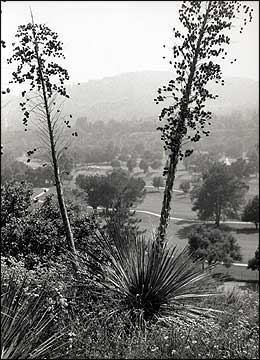
The wilderness provides virtually all of our needs if we have trained our brain and eyes to see what is before us, and if we have learned to identify actual needs (as opposed to whims and wants). A knife and a tool to make fire provide us with the means to produce most of our needs. In addition to a knife and firestarter, I always like to carry a small ball of very versatile twine. Strange as it may sound, a piece of twine or rope could make the difference between life and death. Fortunately, many plants in the wilderness provide us with ample fibre for making rope and twine.
In the foothills, deserts, and mountains of the West and Southwest U.S., two common plants provided generations of Native Americans with all the cordage they needed. These two plants are the yucca and agave. On one of the outings I conducted, we focused exclusively upon making as many products as possible from the yucca and agave.

One Saturday I met with a small group of students and hiked a few miles along a narrow trail in the Angeles Forest. Eventually, we came to a site where a cabin once sat, now all ruins, overgrown with ivy. Nearby was a thick patch of over a hundred agave plants, which have large bluish leaves over three feet long. Many of the agaves had matured, and their 25 foot tall flower stalks stood graceful watch over the patch. We found one stalk that had fallen over. It was about a foot thick at the base. The agave stalk has a hard outer rind, but the inside is soft and pithy. I advised everyone to take a little of the pith to add to their tinder boxes, since this was a nearly ideal tinder. Then, within a few minutes, we each cut off a three foot length of the stalk to use in crafting a quiver-like carrying case. (Yucca's dry stalk can be used identically, though yucca tends to be smaller.) The four of us carried our pieces of the agave stalk further upstream where we could sit in the shade and work on hollowing out the agave stalks. Everyone began the hollowing with a knife, but you can only reach so far with a sheath knife. So I showed everyone how to sharpen the end of a three-foot stick to be used for hollowing out the remainder of the stalk. Everyone finished their hollowing in about an hour and a half. Now we needed to add straps to each of the tubular quivers in order to carry it. This time we collected fresh leaves from a nearby patch of yucca plants. Yucca leaves are thin, narrow and sharp-pointed. When they send up their flower stalks, a profusion of creamy-white flowers follows. Yucca is an excellent fibre source with many other uses besides just rope. But rope was all we needed at the moment, so I instructed everyone in carefully stripping the leaves into even thinner segments, until each person had what looked liked a pile of thick threads. To reduce the leaves to just fibre, we wet the stripped leaves in the river and agitated them between our hands. A wonderful soap results from this process -- in fact, this is possibly the easiest and most-readily available year-round soap of the wilderness. Once the leaves were reduced to mostly fibre, we took our strands and braided them into ropes to use for carrying our agave quivers. The ropes were easily attached to the agave quivers. Everyone fashioned various bottoms for their agave tubes -- the easiest was done by Jimmy, who simply tied his kerchief onto the bottom using some more of the yucca fibre. Though it took us several hours to make our carrying cases using only plants from nature, it illustrated that even without a pack, you can fabricate an excellent carrying case if you know what to look for. The cord made from yucca -- or agave -- has a multitude of uses, from tying together an emergency shelter, to fire-making, to fishing.
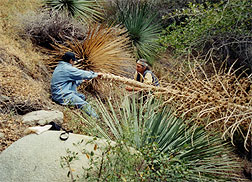

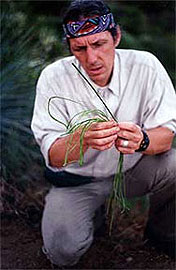
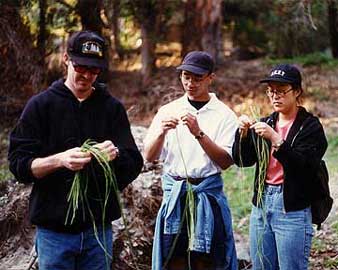
Yucca was used extensively by the Native Americans throughout the Southwest. In the course of one hour of our field trip, I demonstrated the traditional inch-thick sandal that was worn by the Chumash and Gabrielinos who once resided here. It is a simple weave that any child could master in an afternoon. Though agave leaves have a fibre which is as useful as the yucca, the juice of the fresh agave leaves can cause a rash which is equal to a poison oak rash. So when yucca is abundant, I just leave the agave alone.
NEEDLES
The leaf tips of both can be cut, dried, and used for various
sewing or basketry projects, either as a needle or an awl. Depending
on your need, you'll find thin or fat tips, and tips that dry
so hard that they can penetrate canvas. Most are improved upon
drying, but some can be cut fresh and used immediately, if needed.
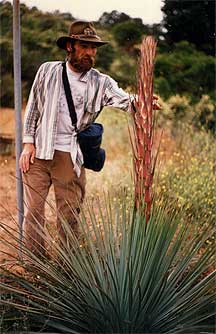
THE SHOOTS
Both the yuccas and agaves which are found in the wild live up
to about 20 years. Then, one spring, they send up a tall flower
spike, produce flowers, then fruit, and then the whole plant dies.
Little babies sprout up around the parent. While these shoots
are sprouting up -- before they sprout side flower branches --
they resemble a huge asparagus shoot. One shoot can have a diameter
up to a foot in thickness and several feet tall. These are an
excellent food source. You cut off the top three feet or so, which
is the most tender. You then peel back the fibrous outer rind.
The insides can be eaten raw, which is akin to jicama in texture
and flavor. Or, you can bake, boil, or roast it -- baking is best.
Generally, when you cut off this shoot, other side shoots develop.
Remember that this flower stalk only occur when the plant is going
to die, and the plant's instinct to produce seed is so compelling
that shoots will continue to grow up until its final act is accomplished.
Also, bear in mind that you should check local regulations, since
it may be illegal to pick this shoot in certain protected areas.
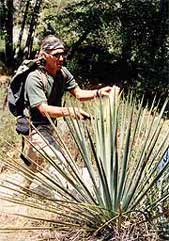
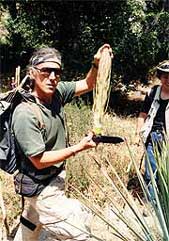

THE FLOWERS
Again, both these plants flower when they are in their final year.
Don't pick the flowers where it is illegal to do so. The yucca
flowers are creamy-yellow to white, depending on species. Some
yucca flowers can be picked off the plant and eaten raw, and they
are good. But most have a slightly soapy under flavor. The best
way I have enjoyed the raw yucca flowers was with a sour cream
dip. We had a bowl of flowers and a bowl of dip, and we just dipped
each flower. The blend of flavors was quite good. Their flavor
is improved by boiling, upon which they can be eaten as-is, or
seasoned with butter or various sauces. The boiled flowers are
also delicious if sauteed for just a few minutes before eating.
Agave flowers are another matter. They are more brightly colored,
and are best cooked -- boiled, or baked. Plant expert John Watkins
told me that while visiting in Mexico City in 1979, he was served
patties made from the agave flowers. He observed the women boiling
the flowers, mashing them into patties, adding herbs, and then
sauteing them. He said they were delicious.
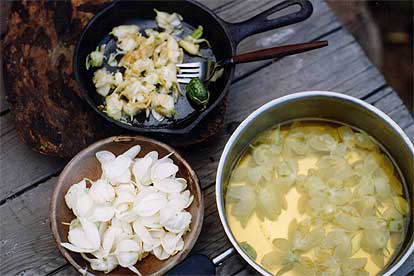
THE FRUITS
Yucca fruits tend to be larger, more plump, and agave fruits tend
to be narrower, smaller. Typically, you find these during the
summer under the yucca or agave plants. If the fruits are still
on the stalk, you might be able to shake the stalk to loosen up
a few. To use either of these fruits, you want to collect them
while they are still tender. You simply cut one open, and if the
inside is white, it's still young and tender. As they get older,
the seeds mature and turn black, and the fruits are less palatable.
The flavor of these fruits is similar in both -- somewhat like raw squash, and often a mild bitter or soapy flavor. They are definitely best when roasted, boiled, or baked. I recommend you try them plain at first, and then experiment with various methods of preparation. Mashing the boiled fruits into patties, and then sauteing them, often produces a delicious food. My most common method of preparation is to place a few dozen of the tender fruits directly in the ash around the edges of a firepit. Don't put the fruits right into the fire, but let the fire burn awhile so you have a good hot bed of coals. Then place the fruits around the edges, and let them cook. Generally, they'll be ready to eat in under 30 minutes. With no seasoning, you'll find these fruits interestingly sweet, and often with just a slight bitter under-flavor.
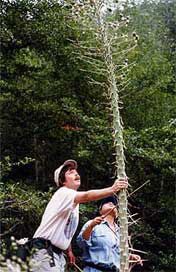
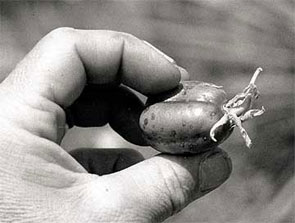
THE SEEDS
The flat black seeds from both plants have been used for centuries
by various Western Native Americans. The seeds are used in a variety
ways, either group into a flour for bread-type products, or cooked
into a porridge-like mush. The flavor of each is similar, but
it all depends how you prepare them. Though I generally have found
these to be acceptable, some people tell me that they do not like
the seeds. However, after a few days with no food, most people
will enjoy the nutritious seeds cooked into porridge, or made
into bread or pancakes. (It's amazing how hunger will affect your
food preferences!)
CONTRAST
Though yuccas and agaves are very similar with regards to their
fibre, and the edibility of the shoots, the flowers, seeds, and
fruits, there are some important distinctions between these two.
Keep in mind that until somewhat recently, botanists considered
Yucca saps. and Agave sps. as members of the Lily family -- that
is, akin to asparagus and onions. But today, after closer scrutiny
of botanical differences, they classify Yucca sps. in its own
Yucca Family, and Agave sps. in its own Agave Family. Still, the
two groups are so close that we can call them "cousins."
Here's how they differ in important ways.
YUCCA
Yuccas are generally smaller than agaves. Their leaves are narrow
and long, and typically light green. They resemble big pin cushions.
The flower stalks rise up about 10, maybe 15 feet, and they produce
cream-colored flowers. Yucca is unique in that it is one of the
best soap plants. Though the root has long been used, you can
extract an excellent soap simply by shredding a green leaf, adding
water, and agitating between the hands.
AGAVE
Agaves are generally much larger than yuccas. Their leaves are
wide and broad -- the leaf can be up to a foot broad at the base
and up to four feet long. They are often a shade of blue-green.
The flower stalks arise up to 25 tall, and the flowers are more
colorful than yuccas -- bright yellows and oranges. Agave has
two unique properties. It produces both paper and water with little
processing. The skin or epidermal layer of the mature agave leaf
can be carefully peeled to produce a parchment. When dried, it
can be used for notes or letters. There is no other plant in nature
that I am aware of from which a paper can be so easily produced.
Birch bark comes to mind, but birch bark is thick and not at all
like modern paper. To obtain water, you cut the central spike
of agave horizontally. You then cut out a bowl in this central
spike, and cover it, and come back in a few hours. Drinkable water
seeps into this bowl, and will continue to do so at the rate of
up to a quart a day for up to a month. This is a mildly sweet
water which you can actually drink as-is. Aside from the tapping
of certain trees -- like sycamore -- I know of no other plant
which produces such a readily palatable water. Even cactus doesn't
truly produce "free" water. In the case of cactus, you
eat your water. Another distinction about agave is that it has
a large starchy core, called the caudex. This can be as big as
a human head, and it located at ground level, just above the roots,
and just below the central spike. Harvesting it kills the plant,
and requires a fair amount of work. I have eaten this a few times.
Properly baked -- which means slowly for several hours -- it has
a delicious flavor like a mildly sweet squash. If cooked too quick,
there is a bitter under flavor that persists.
Agave is also the source of tequila. However, I don't want
to contribute to anyone's delinquency, so if you want to know
more about this, most library's have ample reference materials.
But remember: The fresh juice from the leaves of agave causes
serious itching and usually a rash if you get it on your skin.
For this reason, I rely almost exclusively on the yuccas for all
the above uses. I typically only use agave when there are no yuccas
around. Yuccas and Agaves are widespread throughout the entire
Southwest, throughout the West, Great Basin, and Plains. They
are extremely valuable plants to know. In fact, I have only scratched
the surface here. I recommend that you observe where these plants
grow, and learn more about them. My book, Guide to Wild Foods,
has a chapter on each the Agave and Yucca, and provides additional
details. Another exceptional book on the use of fibre is Survival
Arts of the Primitive Paiutes by Margaret Wheat (University
of Nevada Press, Reno, NV). Also highly recommended is Temalpakh:
Cahuilla Indian Knowledge and Usage of Plants by Saubel and
Bean (Malki Museum Press, Morongo In Reservation, Banning, CA).
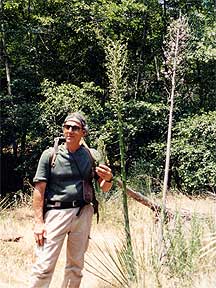
E-mail your comments to "Christopher Nyerges" at
nyerges@hotmail.com
Nyerges is the author of Guide to Wild Foods ($17), Testing
Your Outdoor Survival Skills ($15), and Enter the Forest
($10). These books and videos are available from the School of
Self-Reliance, Box 41834, Eagle Rock, CA 90041. Nyerges has led
survival skills classes since 1974. The schedule of his classes
is available in the Talking Leafs Newsletter. For more information,
see the School of Self-Reliance website at www.self-reliance.net
or www.home.earthlink.net/~cnyerges.
We hope the information on the PrimitiveWays website is both instructional and enjoyable. Understand that no warranty or guarantee is included. We expect adults to act responsibly and children to be supervised by a responsible adult. If you use the information on this site to create your own projects or if you try techniques described on PrimitiveWays, behave in accordance with applicable laws, and think about the sustainability of natural resources. Using tools or techniques described on PrimitiveWays can be dangerous with exposure to heavy, sharp or pointed objects, fire, stone tools and hazards present in outdoor settings. Without proper care and caution, or if done incorrectly, there is a risk of property damage, personal injury or even death. So, be advised: Anyone using any information provided on the PrimitiveWays website assumes responsibility for using proper care and caution to protect property, the life, health and safety of himself or herself and all others. He or she expressly assumes all risk of harm or damage to all persons or property proximately caused by the use of this information.
© PrimitiveWays 2013